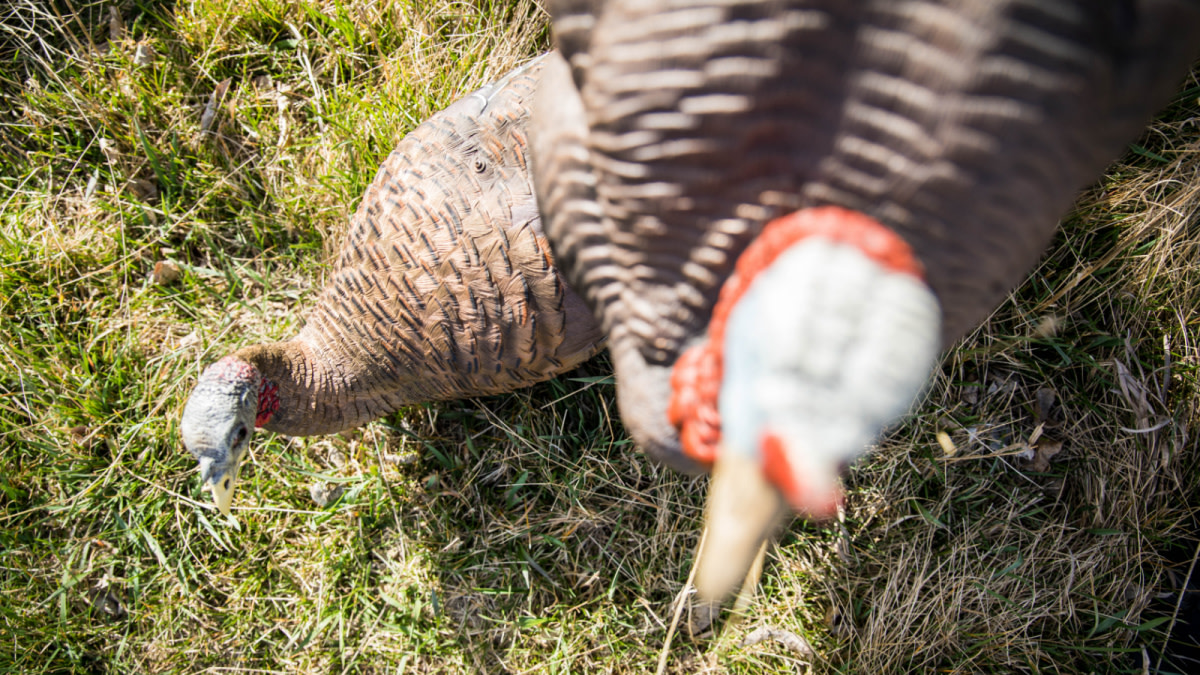
The truth is, most hunters will capitalize on every advantage they can buy. If they say otherwise, they’re probably lying. This is definitely true when it comes to today’s world of ultra-realistic turkey decoys. When given the option, I’ll admit, realistic decoys are worth every penny. This is especially true for the bowhunter who needs toms to be hypnotized if they want half a chance at drawing their bows. However, equally important is which decoys you use, when, and where you place them. Bad decoy placement will have you walking back to the store for a refund, while a few punched tags will leave you a lifelong believer.
Truthfully, the best decoy advice I can give is to seek out a location that turkey frequent, stake out your decoys, and put in your time. Nothing tips turkeys off like a fake squatting in a place that they don’t go often and don’t want to be. To increase your odds, use your whitetail knowledge of funnels and terrain features to put the decoys in a gobbler’s most likely path of approach. Use downed timber, cliffs, drainages, thick vegetation, and fence crossings to your advantage when determining where to set your decoys.
The Full Flock This tactic is best deployed early in the season when birds are still flocked up. Just like adjusting your calling sequence seasonally, or striving to “match the hatch” on a trout stream, a large spread of decoys will look more realistic than a lone hen in the early season. On the contrary, a spread of six dekes will look out of place when hens split up to find nesting locations and bachelor groups separate accordingly.
A hard learned lesson comes to mind. I had a lone tom gobbling and 100% committed to my calls. When he got a visual of my multiple bird flock, including a quarter-strut jake, he turned inside out and pulled an abrupt 180. I learned it was probably too late in the season for this spread and this tom was certainly not the dominant bird in the pecking order.
Consider buying cheap decoys to supplement your arsenal. While I love the realistic look of a high-priced hen decoy, and will use them every chance I get, 90% of the time the tom doesn’t pay an ounce of attention to the hen decoys and comes in to establish his dominance with Mr. Jake. He likely won’t even give second thought to that one hen decoy whose paint scheme doesn’t quite match the rest of the hens. With this strategy, quantity is the goal, in hopes of drawing more attention from large flocks of hens with multiple gobblers in tow.
The Breeder We’ve likely all seen advertisements for breeding hen decoys; they’ve been around for quite some time. The idea behind these decoys is to give surrounding gobblers the impression that she’s ready and willing to breed. When paired with an ensuing tom or jake decoy, this changes the dynamic of your decoy spread and often results in piqued curiosity.
If you don’t have a hen in a breeder position, there is another solution. Whether you have a feeding hen or a looker, positioning relative to your gobbler decoy changes the vibe that your spread puts out. A tom or jake decoy spaced 5 yards from your hen decoy will give gobblers the impression that this short-bearded fella is simply following a hen in hopes of courtship. Alternatively, staking your male decoy within a couple feet of the hen gives the visual that something more is happening between these two birds.
The Mover Few things make a decoy spread look phonier than a bird on a stick that hasn’t moved an inch. This is increasingly problematic if your setup lies on a field edge and has been in plain sight to the gobbler for long periods of time. Adding motion to your decoy can be the tipping point in getting decoy-shy gobblers to commit. The simplest way to add motion to your spread is by picking a decoy that moves easily in light winds. Full strut decoys tend to catch more wind and spin readily, as do lightweight decoys.
Sometimes the type of stake that you use can also make a difference. My favorite decoy, a quarter-strut jake, features a stake commonly used by waterfowlers who swear up and down that decoys need motion to look realistic. This decoy spins freely on the stake and has an elastic cord to keep your decoy from spinning like a windmill on gusty days. Lastly, there are a few motion stakes on the market, some of which are electronic. Admittedly, I haven’t tried these stakes just yet, but if another bird hangs up within eyesight of my spread, one will probably be in my shopping cart soon. Remember that electronic decoys may not be legal in every state.
To maximize the effectiveness of your decoys, your tactics and selection should change as the season progresses. Study wild birds in real time and match your decoy spread for ultimate realism. Lastly, choose a setup location that gives you the advantage. Put the decoys in a place that redirects a tom’s natural movement right into your lap; your faux birds will be too close and far too tempting for that longbeard not to come in and investigate.






Conversation